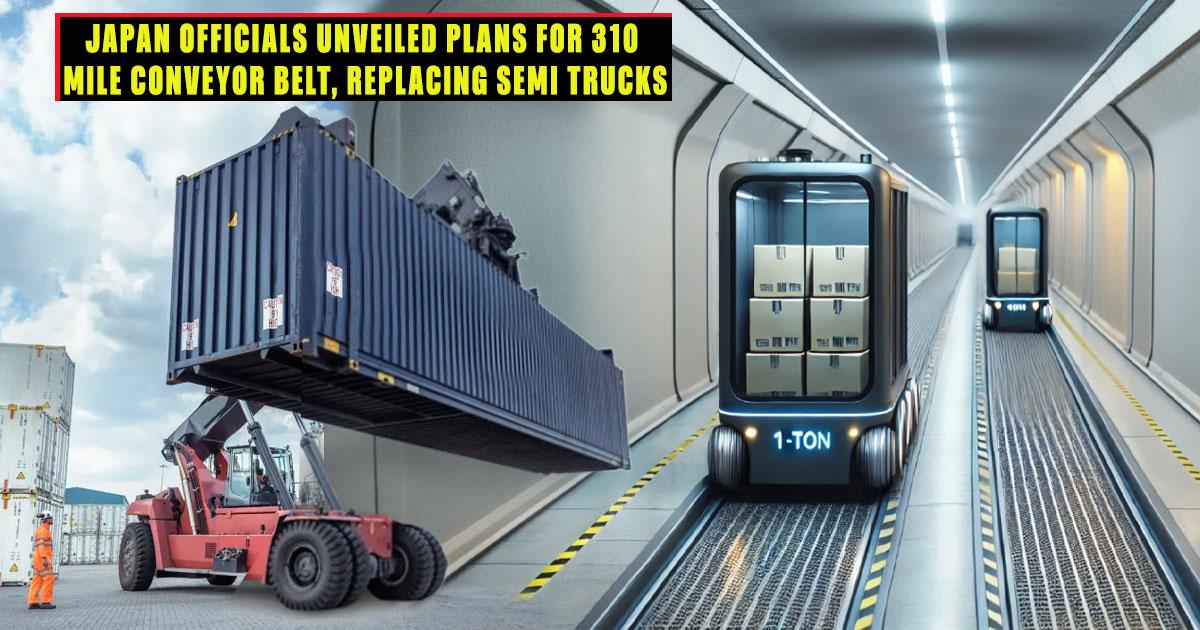R.E.News International-Japan’s 310 mile Conveyor Belt could revolutionise Freight Transport
 13/08/24-FR-English-NL-footer
13/08/24-FR-English-NL-footer
Le tapis roulant japonais de 500 km pourrait révolutionner le transport de marchandises
 Image- (MLIT)
Image- (MLIT)
Le gouvernement japonais a jeté son dévolu sur une initiative révolutionnaire qui promet de transformer le paysage logistique du pays.
Ce projet audacieux, l’Autoflow-Road, vise à établir un réseau de tapis roulants automatisés de haute technologie s’étendant sur 500 kilomètres entre Tokyo et Osaka. Alors que le Japon est aux prises avec une grave pénurie de chauffeurs-livreurs et une demande croissante de fret, cette solution innovante pourrait changer la donne.
Le ministère japonais du Territoire, des Infrastructures, des Transports et du Tourisme (MLIT) a récemment annoncé ce plan ambitieux, soulignant son potentiel pour atténuer la crise logistique imminente. Le projet Autoflow-Road, conçu pour assurer le mouvement efficace et continu des marchandises, pourrait alléger considérablement la pression sur le système de livraison japonais.
Shuya Muramatsu, un haut fonctionnaire du bureau de recherche en économie routière du MLIT, a souligné l’importance du projet. « Les routes logistiques automatisées sont conçues pour tirer le meilleur parti de l’espace routier en utilisant des accotements, des bandes médianes et des tunnels sous la chaussée », a-t-il expliqué.
Au-delà de relever les défis logistiques, l’Autoflow-Road s’aligne également sur les objectifs environnementaux du Japon. Le projet vise à réduire les émissions de gaz à effet de serre (GES) en exploitant plus efficacement l’espace routier existant. En intégrant des tunnels, des bandes médianes et des accotements, le projet cherche à minimiser l’empreinte environnementale du transport de marchandises.
Muramatsu a ensuite développé les avantages environnementaux en déclarant : « Notre étude examine l’impact sur le trafic routier, y compris sur les routes environnantes, et les coûts. » Cette approche globale garantit que l’Autoflow-Road est non seulement pratique mais aussi durable.
Le système Autoflow-Road est encore en phase de planification, mais sa conception proposée est tout simplement révolutionnaire. Des bandes transporteuses automatisées seront installées dans des tunnels sous les principales autoroutes, sur des voies en surface au milieu des routes et le long des accotements des autoroutes. Cette approche multidimensionnelle maximise l’utilisation de l’espace disponible tout en minimisant les perturbations du trafic existant.
Le ministre des Transports Tetsuo Saito, s’exprimant lors de l’inauguration du projet, a souligné les avantages multidimensionnels de l’Autoflow-Road. « L’Autoflow-Road permettra non seulement de résoudre la crise logistique, mais aussi de réduire les émissions de gaz à effet de serre. Nous souhaitons accélérer les discussions sur le sujet », a déclaré Saito.
Si l’Autoflow-Road promet de nombreux avantages, elle présente également plusieurs défis. L’impact du projet sur le trafic routier, les infrastructures environnantes et les coûts globaux sont des considérations essentielles. Muramatsu a souligné l’importance d’une analyse approfondie pour garantir la faisabilité et l’efficacité du projet.
Pour faire face aux perturbations potentielles, le gouvernement prévoit de mener des études et des simulations approfondies. Celles-ci permettront d’anticiper et d’atténuer les effets négatifs sur les usagers de la route existants et les communautés locales.
Le projet Autoflow-Road a des implications économiques importantes. En rationalisant le transport de marchandises, il pourrait réduire les coûts pour les entreprises et les consommateurs. Une logistique plus rapide et plus efficace pourrait stimuler l’économie japonaise, améliorant ainsi la compétitivité sur le marché mondial.
De plus, le projet pourrait créer de nouvelles opportunités d’emploi dans les secteurs de la construction, de la maintenance et de la technologie. Alors que le Japon continue d’innover, de telles initiatives soulignent son engagement en faveur de la croissance économique et de la durabilité.
Le projet Autoflow-Road du Japon suscite l’attention internationale. S’il réussit, il pourrait servir de modèle à d’autres pays confrontés à des défis logistiques similaires.
L’utilisation innovante de la technologie et des infrastructures par le projet pourrait inspirer des avancées mondiales dans le transport de marchandises.
Alors que le Japon se lance dans ce voyage ambitieux, le monde entier observe avec un vif intérêt. Le projet Autoflow-Road incarne l’esprit d’innovation et de résilience qui définit le Japon.
En répondant aux défis logistiques et aux préoccupations environnementales, il crée un précédent pour les futurs projets d’infrastructure.
NJC.© Info (MLIT)
----------------------------------------------------------------------------------------------------------------
 13/08/24/English
13/08/24/English
Japan’s 310 mile Conveyor Belt could revolutionise Freight Transport
 Image-(MLIT)
Image-(MLIT)
The Japanese government has set its sights on a ground-breaking initiative that promises to transform the country’s logistics landscape.
This audacious project, the Autoflow-Road, aims to establish a network of hi-tech, automated conveyor belts stretching 310 miles (500 kilometres) between Tokyo and Osaka. As Japan grapples with a severe delivery driver shortage and mounting freight demands, this innovative solution could prove to be a game-changer.
Japan’s Ministry of Land, Infrastructure, Transport, and Tourism (MLIT) recently announced this ambitious plan, highlighting its potential to mitigate the looming logistics crisis. The Autoflow-Road project, designed to ensure the efficient and continuous movement of cargo, could significantly alleviate the strain on Japan’s delivery system.
Shuya Muramatsu, a senior official in MLIT’s road economics research office, underscored the project’s significance. “Automated logistics roads are designed to get the most out of road space by utilizing hard shoulders, median strips [central reservations], and tunnels beneath the roadway,” he explained.
Beyond addressing logistical challenges, the Autoflow-Road also aligns with Japan’s environmental goals. The project aims to reduce greenhouse gas emissions (GHGs), leveraging existing road space more efficiently. By incorporating tunnels, median strips, and hard shoulders, the project seeks to minimize the environmental footprint of freight transport.
Muramatsu further elaborated on the environmental benefits, stating: “Our study is examining the impact on road traffic, including on surrounding roads, and costs.” This comprehensive approach ensures that the Autoflow-Road is not only practical but also sustainable.
The Autoflow-Road system is still in the planning phase, but its proposed design is nothing short of revolutionary. Automated conveyor belts will be installed in tunnels beneath major highways, on above-ground tracks in the middle of roads, and along hard shoulders of motorways. This multifaceted approach maximizes the use of available space while minimizing disruption to existing traffic.
Transport Minister Tetsuo Saito, speaking at the project’s unveiling, highlighted the multifaceted benefits of the Autoflow-Road. “The Autoflow-Road will not only address the logistics crisis but also help to reduce greenhouse gas emissions. We would like to speedily proceed with discussions on the matter,” Saito remarked.
While the Autoflow-Road promises numerous benefits, it also presents several challenges. The project’s impact on road traffic, surrounding infrastructure, and overall costs are critical considerations. Muramatsu emphasized the importance of a thorough analysis to ensure the project’s feasibility and effectiveness.
To address potential disruptions, the government plans to conduct extensive studies and simulations. These will help anticipate and mitigate any adverse effects on existing road users and local communities.
The Autoflow-Road project has significant economic implications. By streamlining freight transport, it could reduce costs for businesses and consumers alike. Faster and more efficient logistics could boost Japan’s economy, enhancing competitiveness in the global market.
Moreover, the project could create new job opportunities in construction, maintenance, and technology sectors. As Japan continues to innovate, such initiatives underscore its commitment to economic growth and sustainability.
Japan’s Autoflow-Road project is garnering international attention. If successful, it could serve as a model for other countries facing similar logistics challenges.
The project’s innovative use of technology and infrastructure could inspire global advancements in freight transport.
As Japan embarks on this ambitious journey, the world watches with keen interest. The Autoflow-Road project embodies the spirit of innovation and resilience that defines Japan.
By addressing logistical challenges and environmental concerns, it sets a precedent for future infrastructure projects.
NJC.© Info (MLIT)
---------------------------------------------------------------------------------------------------------------
 13/08/24-NL
13/08/24-NL
De 310 mijl lange transportband van Japan kan het goederenvervoer revolutioneren
 Image- (MLIT)
Image- (MLIT)
De Japanse overheid heeft haar zinnen gezet op een baanbrekend initiatief dat belooft het logistieke landschap van het land te transformeren.
Dit gedurfde project, de Autoflow-Road, heeft als doel een netwerk van hightech, geautomatiseerde transportbanden op te zetten dat zich uitstrekt over 310 mijl (500 kilometer) tussen Tokio en Osaka. Nu Japan worstelt met een ernstig tekort aan bezorgers en toenemende vraag naar vracht, zou deze innovatieve oplossing een gamechanger kunnen blijken te zijn.
Het Japanse ministerie van Land, Infrastructuur, Transport en Toerisme (MLIT) heeft onlangs dit ambitieuze plan aangekondigd en benadrukt dat het de dreigende logistieke crisis kan verzachten. Het Autoflow-Road-project, dat is ontworpen om de efficiënte en continue verplaatsing van vracht te garanderen, zou de druk op het Japanse bezorgsysteem aanzienlijk kunnen verlichten.
Shuya Muramatsu, een hoge functionaris bij het onderzoeksbureau voor wegeconomie van MLIT, benadrukte het belang van het project. "Geautomatiseerde logistieke wegen zijn ontworpen om het maximale uit de wegruimte te halen door gebruik te maken van vluchtstroken, middenbermen [middenbermen] en tunnels onder de weg", legde hij uit.
Naast het aanpakken van logistieke uitdagingen, sluit de Autoflow-Road ook aan bij de milieudoelstellingen van Japan. Het project is gericht op het verminderen van de uitstoot van broeikasgassen (BKG's) door bestaande wegruimte efficiënter te benutten. Door tunnels, middenbermen en vluchtstroken op te nemen, probeert het project de ecologische voetafdruk van goederenvervoer te minimaliseren.
Muramatsu ging verder in op de milieuvoordelen en verklaarde: "Onze studie onderzoekt de impact op het wegverkeer, inclusief op omliggende wegen, en de kosten." Deze uitgebreide aanpak zorgt ervoor dat de Autoflow-Road niet alleen praktisch maar ook duurzaam is.
Het Autoflow-Road-systeem bevindt zich nog in de planningsfase, maar het voorgestelde ontwerp is ronduit revolutionair. Geautomatiseerde transportbanden worden geïnstalleerd in tunnels onder grote snelwegen, op bovengrondse sporen in het midden van wegen en langs vluchtstroken van snelwegen. Deze veelzijdige aanpak maximaliseert het gebruik van beschikbare ruimte en minimaliseert de verstoring van bestaand verkeer.
Minister van Transport Tetsuo Saito, die sprak bij de onthulling van het project, benadrukte de veelzijdige voordelen van de Autoflow-Road. "De Autoflow-Road zal niet alleen de logistieke crisis aanpakken, maar ook helpen de uitstoot van broeikasgassen te verminderen. We willen snel verder met de besprekingen over deze kwestie", merkte Saito op.
Hoewel de Autoflow-Road talloze voordelen belooft, brengt het ook verschillende uitdagingen met zich mee. De impact van het project op het wegverkeer, de omliggende infrastructuur en de totale kosten zijn cruciale overwegingen. Muramatsu benadrukte het belang van een grondige analyse om de haalbaarheid en effectiviteit van het project te garanderen.
Om mogelijke verstoringen aan te pakken, is de overheid van plan om uitgebreide studies en simulaties uit te voeren. Deze zullen helpen om eventuele negatieve effecten op bestaande weggebruikers en lokale gemeenschappen te anticiperen en te beperken.
Het Autoflow-Road-project heeft aanzienlijke economische implicaties. Door het goederenvervoer te stroomlijnen, zou het de kosten voor zowel bedrijven als consumenten kunnen verlagen. Snellere en efficiëntere logistiek kan de Japanse economie stimuleren en zo de concurrentiekracht op de wereldmarkt vergroten.
Bovendien kan het project nieuwe banen creëren in de bouw-, onderhouds- en technologiesector. Nu Japan blijft innoveren, onderstrepen dergelijke initiatieven de toewijding aan economische groei en duurzaamheid.
Het Japanse Autoflow-Road-project trekt internationale aandacht. Als het succesvol is, kan het dienen als een model voor andere landen die met soortgelijke logistieke uitdagingen te maken hebben.
Het innovatieve gebruik van technologie en infrastructuur door het project kan wereldwijde vooruitgang in goederenvervoer inspireren.
Terwijl Japan aan deze ambitieuze reis begint, kijkt de wereld met grote interesse toe. Het Autoflow-Road-project belichaamt de geest van innovatie en veerkracht die Japan definieert.
Door logistieke uitdagingen en milieuproblemen aan te pakken, schept het een precedent voor toekomstige infrastructuurprojecten.
NJC.© Info (MLIT)
-------------------------------------------------------------------------------------------------------------------
Date de dernière mise à jour : 12/08/2024

















